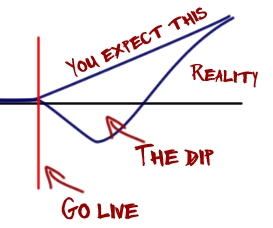Are you prepared for the dip?
So you are refreshing or rebuilding your website. You are introducing new functionality and features, and sweeping away the old. You’ve done usability testing of your new concepts and the results are positive. Success awaits. You go live. And it doesn’t quite go as you expected. You expect that the numbers and feedback will go on an upward trajectory from day one, but they don’t. What you should have expected is the dip.
In October 2009 Facebook redesigned the news feed. Users were up in arms, groups were formed and noisy negative feedback was abound. A couple of years back the BBC redesigned their newspage, “60% of commenters hated the BBC News redesign“. Resistance to change is almost always inevitable, especially if you have a vocal and loyal following, you can expect much dissent to be heard. What is interesting is what happens next. Hold your nerve and you will get over this initial dip. We’ve seen a number of projects recently where this phenomenon occurred; numbers drop and negative feedback is loudly heard. But this dip is ephemeral and to be expected. The challenge is in planning for this and setting expectations accordingly. Telling your CEO that the new design has resulted in a drop in conversion rate is going to be a painful conversation unless you have set her expectations that this is par for the course.
Going live in a beta can help avert the full impact of the dip. You can iron out issues and prepare your most loyal people for the change, inviting them to feedback prior to the go-live. Care must be taken with such an approach in the sample selection o participate in the beta. If you invite people to ‘try out our new beta’, with the ability to switch back to the existing site, you are likely to get invalid results. The ‘old’ version is always available and baling out is easy. Maybe they take a look and drop out, returning to the old because they can. Suddenly you find the conversion rates of your beta falling well below those of your main site. Alternatively use A/B testing and filter a small sample to experience the new site. That way you will get ‘real’ and representative data to make informed decisions against. Finally, don’t assume that code-complete and go-live are the end of the project. Once you are over the dip there will be changes that you can make to enhance the experience and drive greater numbers and better feedback.


